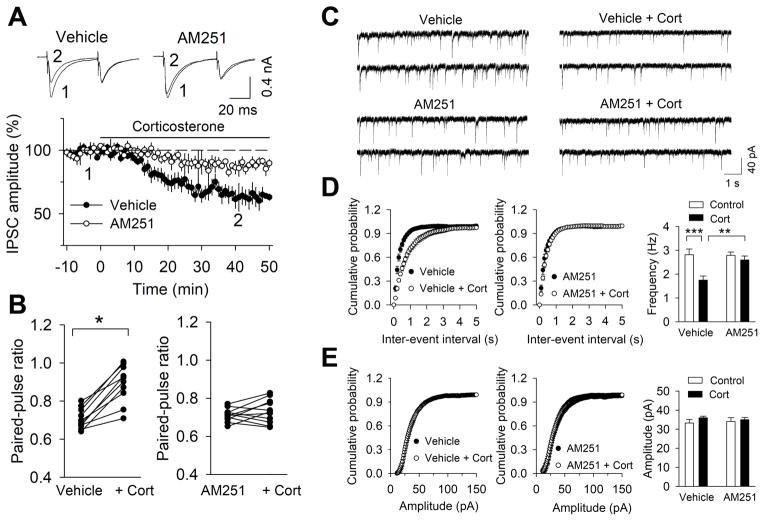Figure 2.
Corticosterone depressed evoked and miniature inhibitory post-synaptic currents through a cannabinoid receptor type 1 (CB1R)-dependent mechanism in rat prelimbic slices. A) Bath application of corticosterone (Cort; 1 μM) caused rapid depression of evoked IPSCs (n=10 neurons; n=2–3 rats) in layer V pyramidal neurons in the prelimbic cortex (PL) which were blocked by the CB1R antagonist AM251 (2 μM, n=11 neurons; n=2–3 rats). B) Bath application of corticosterone increased the paired-pulse ratio (PPR) which was blocked by AM251 (n=11 neurons; n=2–3 rats, p<.05). C) Representative traces of mIPSCs recorded in layer V pyramidal neurons in PLC slices that were treated with vehicle (control), Cort (1 μM), AM251 (2 μM) or AM251 plus Cort (1 μM). D) Corticosterone treatment decreased the mean frequency of mIPSCs (n=9–11 neurons; n=2–3 rats, p<.01) and caused a right shift of the inter-event intervals of the cumulative probability plot. However, in the presence of AM251, corticosterone did not alter the mean frequency of mIPSCs (n=10–11 neurons; n=2–3 rats, p>.05) or inter-event intervals of the cumulative probability plot. E) Corticosterone did not alter the mean amplitude of mIPSCs (p>.05) and cumulative amplitude distribution. In addition, in the presence of AM251, corticosterone had no significant effect on the mean amplitude of mIPSCs (p>.05) or on the cumulative amplitude distribution of mIPSCs.

